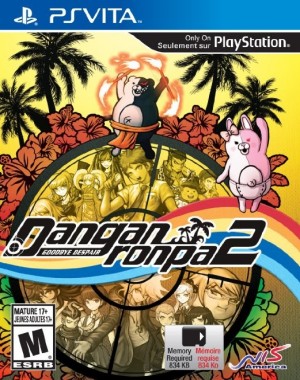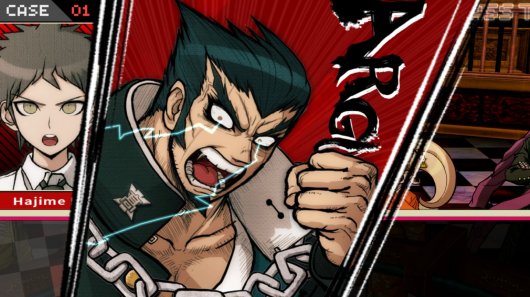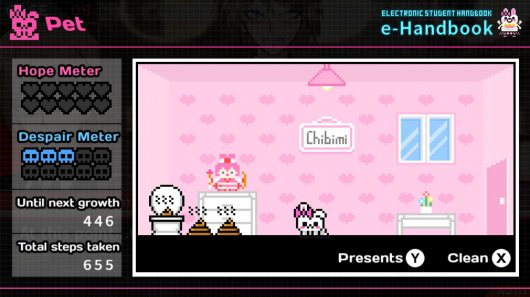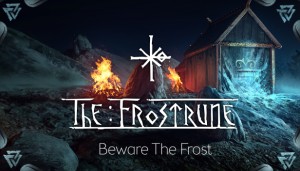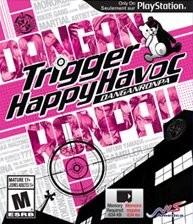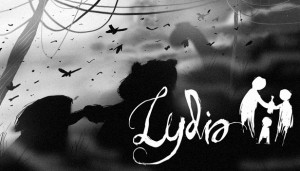Review for Danganronpa 2: Goodbye Despair
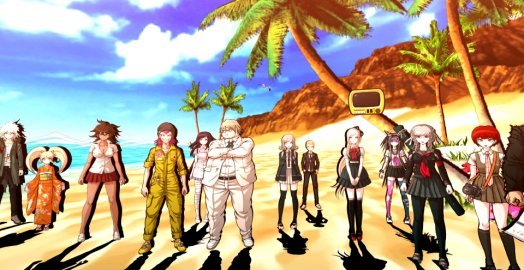
Game information
It’s said that misery loves company. With that in mind, developer Spike Chunsoft decided to follow the first installment of their teenage murder mystery franchise Danganronpa by upping the ante and driving even more hapless participants of its deadly game to the farthest reaches of hopelessness and desperation. Danganronpa 2: Goodbye Despair features the same over-the-top characterizations, quirky black humor, and ultra-violence that fans of its precedessor would expect. However, as with Trigger Happy Havoc, the class trial sections, despite introducing a number of new gameplay elements, continue to get in the way of the fun, somewhat marring what is otherwise a sequel that raises the bar on all fronts.
Goodbye Despair follows the same premise as the first game: sixteen Hope’s Peak Academy students, each of them the most talented in their specific field, find themselves trapped and forced to participate in a series of deadly games of murder to earn chances at escape. By killing a fellow schoolmate, and subsequently getting away without being found out, a student may earn the privilege to “graduate” and leave, while all others will share the fate of the deceased. It’s the other students’ – and by extension, the player’s – job to investigate the crime scene locations, gather clues and evidence, and prove who each killer is in a courtroom mock-up. If the murder is solved correctly, the culprit is lethally punished, typically in an outrageous or gruesome manner, and the cycle begins anew with the ever-shrinking group of survivors.
The gameplay setup of both games is identical, though the individual details give this sequel an identity all its own. The most obvious change, apparent as early as the title screen, is that the game is set on a secluded tropical island paradise this time around, as opposed to the oppressively claustrophobic school building of the first game. The vibrant tropical setting is an interesting choice for a brutal thriller, and it presents as many mysteries as the previous setting. Then there’s the presence of Magical Miracle Girl Usami, later renamed Monomi, a talking pink plush bunny, similar to series antagonist Monokuma, who claims she is a Hope’s Peak teacher and in charge of the students during their Killing School Trip to Jabberwock Island. The sadistic stuffed bear mascot himself is of course also back in the mix, and his interactions with Monomi, whom he refers to as his younger sister, are a constant source of bewildered amusement.
As the body count rises and the surviving students take part in one trial after another, new sections of Jabberwock Island become available for exploration. The narrative, though decidedly linear, does a great job at pacing events, introducing interesting new locations, and presenting (and occasionally resolving) new mystery hooks over the course of its rather considerable 30 - 40 hour length. Especially during the final chapter or two, unpredictable events unfold at a breakneck pace, to the point where I found myself slack-jawed a few times during the story’s finale.
Environmental exploration occurs by pointing and clicking an on-screen reticle on areas of interest. Though most locations can be explored in this way (with the exception of the courtroom setting and those meant solely for navigating around the island), the amount of interactive hotspots is often less than stellar, and sometimes downright sparse. This is offset by the sheer volume of text that appears as a result of conducting your investigations and speaking with Hajime’s classmates. At a guess, roughly 85-90% of the game’s runtime is devoted to straightforward visual novel gameplay, namely reading text.
Some of that text occurs in the Daily Life sections, which primarily serve to let players, who take on the role of protagonist Hajime Hinata, walk around the island and hang out with the other students, revealing their backstories in a piecemeal fashion – assuming they’re not killed off first. While this feature was one of my least favorite in the previous game, I took to it more this time around; figuring out which gifts to give to each student in order to unlock his or her complete backstory and earn a special skill to use during courtroom sections seems much more intuitive than before. Of course, it’s worth noting that these Daily Life sections, which cut right into the overarching narrative, happen with less frequency in the later stages of the game, when the story begins to roll full steam ahead, and are completely skippable when they do occur.
The writing also features some notable improvements this time around, which contributes to making the Daily Life sections more palatable. That’s not to say the first game’s writing was subpar, but on the whole Goodbye Despair does a better job motivating you to build relationships with Hajime’s classmates. From the outset, during the introductory chapter, progression is based on speaking with the other students and obtaining Hope Fragments from them for doing so. Throughout the game, these Hope Fragments are a visual representation of how close Hajime is to each character, and the verbal exchanges to get there make the characters easier to care about.
In fact, the script even succeeds in evoking real emotion. As early as the very first murder case, I found myself sympathizing with the acts perpetrated by the killer, and wishing for an unexpected “No Punishment” twist. Some characters’ motivations aren’t purely black or white, and the complicated scenarios that spin out of this can be truly tragic and heart-breaking. At the same time, there are genuine moments of laugh-out-loud levity in the game, and parts that burst with hope and optimism, and these finely crafted moments encourage players to get emotionally invested.
The characters themselves are a huge contributing factor to the overall enjoyment. I praised the last game for its character designs, and Danganronpa 2, if anything, may have outdone its predecessor. As ever, the models are bold, colorful, and larger than life, exaggerated in ways that make them truly unique – no mean feat with a total of thirty-two characters spread over two games. Particular standouts this time around include such distinctive personalities as Gundham Tanaka, the Ultimate Breeder, with his four pet hamsters affectionately known as the Four Dark Devas of Destruction, who continuously pop out of his outfit and even complete tasks for him; and the mysterious Ultimate Imposter, about whose true identity little is known but who bears a striking resemblance to someone in the series debut. Each character has opportunity for their personality to shine, be it silly, stand-offish, foul-mouthed, subservient, aloof, or crazed. Those who survive longer than their counterparts even get interesting arcs. A character who might have started the game as insufferable responds to events in such a way that by the later chapters they’ve become invaluable to the group’s survival. The reverse scenario is, of course, also possible.
As much praise as the writing deserves, there are some ways in which it falls a little short. I really appreciate seeing characters respond in ways that seem authentic to their personalities, but with sixteen cast members commenting on any potential situation, it can often start to feel like a case of “everybody has to get their line in.” To be fair, some restraint is evident, as particular students may stay silent during exchanges, but a much more liberal use of the editing pen may have been advisable during development.
Nowhere is this more noticeable than in the trial sections. Each chapter’s pre-trial gameplay will take several hours to get through, but is spread over a couple of in-game days. The trials themselves take place as a continuous event, and are easily as long as what came before. While the cases are enjoyable in their complexity as they unravel, the plodding pace at which they move isn’t. Characters will have endless debates over every niggling detail of a murder. It’s a bit of a catch-22; omit too many details and the player feels shortchanged, but go through everything with a fine-toothed comb and it becomes overkill. The latter offense was at its worst when I had already figured out a particular crime well in advance (don’t worry – this didn’t happen often), but still had to go through the motions to let the characters catch up.
When not engaged in lengthy debates, the class trials are all about a litany of minigames, much like the last game. Some of these are new, but the fact remains that there are still too many of them, and with the exception of the Nonstop Debates, they generally just feel like minigames rather than authentic gameplay that jives well with a courtroom trial. One all-new addition is the Logic Dive, basically a snowboarding level through an obstacle course that tasks you with sliding over answers to specific questions to reach a particular conclusion at the end. A few familiar minigames have returned in altered form, sometimes for the better, like the Closing Arguments that summarize each case at the end; other times, as with Hangman’s Gambit, for the worse. There are about half a dozen distinct minigames altogether, and most of them will come up more than once in each case. The majority are also skill-based, requiring fast reflexes, as in the rhythm-based Panic Talk Action. The list of specialized terms thrown at you in minigame tutorial screens during the first case alone generously fills up an entire notepad page – quite a departure from the gameplay in any other part of Danganronpa.
The minigame barrage is one of the few stains on an otherwise solid mystery, but not every aspect of the class trials is an annoyance. Closing Arguments are enjoyable puzzles, and the Nonstop Debates now feature the ability to not only prove statements wrong but also to agree with statements to prove a vital point. This is a change that makes sense, and adds welcome complexity. In fact, the cases in general are clever, and it can be very satisfying to figure out a murder after going in almost blind to begin with. The other side of that particular coin includes some moments when I honestly didn’t comprehend a statement or response the game wanted me to prove or disprove, and I was forced to take advantage of the unlimited continue option after my Influence Gauge was depleted to zero (which, while it makes certain trophies unattainable, actually gives you an edge by restoring the Influence Gauge back to full and continuing the game just prior to where it ended). These moments required me to brute force my way through a debate by simply using each piece of evidence on each statement until one clicked, which just felt cheap. The game does include menu options to allow you to increase or tone down both the action and logic difficulty, but these settings don’t affect a meaning that might have been lost in translation.
There’s nothing radically different about Danganronpa 2 when it comes to sound and graphics. Musically, the sequel is more pleasant than its predecessor, maybe just by virtue of offering something new to listen to. Many, if not all, of the first game’s scores make a return here, but it’s the new tracks that stand out as better. In particular, Monomi’s theme became a favorite of mine, and I found myself heading to the music menu to listen to it outside of the game proper from time to time. Characters are still voiced well, but once again, most island dialog isn’t voiced at all, while class trials are fully recorded. Graphics also haven’t changed much, with a “2D in 3D space” sensibility that doesn’t do the game any favors. The static environments, at least, work well and are suitably colorful for the tropical setting. Strangely, while some larger locations allow full freedom of movement, traveling from place to place is done in a 2D side-scrolling environment, the only time such a format is used.
Apart from the main narrative, the developers have included some bonus content as well. Players have a virtual pet that can be checked up on, fed, and given presents to throughout. A separate arena mode lets you take control of Monomi and destroy large mechanical beasts to unlock sections of Jabberwock Island (it’s implied that this is how new areas open up in the main story periodically). Completing the game also lets you take the entire cast into Island Mode, a resource gathering mode that allows you to focus on building relationships with all students and exhausting their backstories without having to worry about murder and mayhem. Finally, the light novel “Danganronpa IF”, which depicts an alternate take on the events of the first game, can be accessed after finishing the game.
Calling Goodbye Despair an improvement over the first game in the series is an accurate statement. The game is lengthier, with sharp writing and characterizations, clever murders to unravel, and genuine emotional investment in its cast and their fates. However, that doesn’t mean all the faults evident in the first game have been addressed. Trial sections are still littered with unenjoyable minigames, perhaps more so than before, and the logic behind proving or disproving a statement can occasionally seem about as nonsensical as a talking stuffed bear holding a group of intelligent people hostage on a deserted island for a killing game does in the first place. These issues aside, however, Danganronpa 2 is an easy win for fans of the first game, and visual novels in general. It has an intriguing concept, well-designed characters, and enough charm and pathos to make it a no-brainer, and a clear upgrade over what came before.


